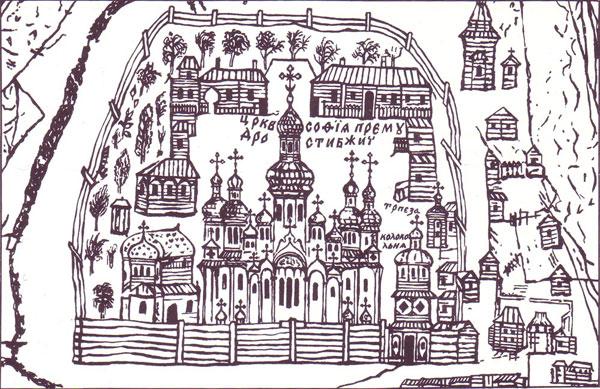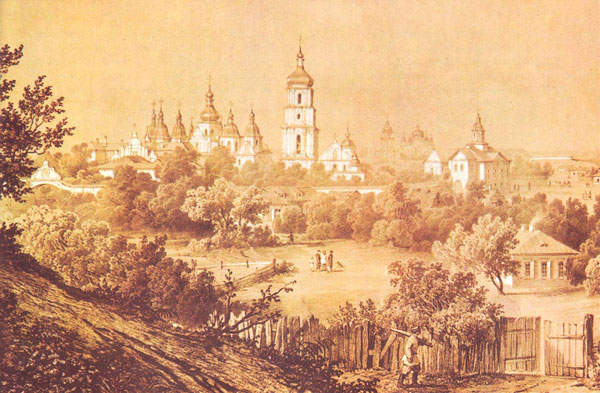ua. ru. en.
Museum ST. SOPHIA CATHEDRAL
Historical information
Plan of museum
ST. SOPHIA CATHEDRAL
Narthex
Architecture and murals
- Plan, Ground floor
- Mosaics
- Frescos
- Graffiti
- other details
Sarcophagus of Yaroslav the Wise
North cloister
Towers
Lofts
- Plan, First floor
ARCHITECTURAL MONUMENTS OF THE 18TH CENTURY
Bell Tower
Seminary
Cells of the Cathedral Elders
Metropolitan's Residence
Refectory
Consistory
South Entrance Tower
Zaborovsky Gate
First Rus library
BRANCHES OF THE MUSEUM
|
|
Excursions Kiev
weekend in Kiev
trip to Kiev
Excursions
tours to Kiev
Sights of Kiev
ARCHITECTURAL MONUMENTS OF THE 18TH CENTURY
The formation of an complex built of stone buildings in the grounds of the St. Sophia Cathedral in Kiev is closely connected with the history of 17th- and 18th- century Ukraine. In the 17th century the formation of the peoples; as well as their three cultures which grew out of that of Old Rus, was fully established. The growth of the Ukrainian people's national consciousness, close economic and cultural contacts with neighboring countries, provided the stimulus for an impetuous rise in Ukrainian economy and culture.
At this time in the Ukraine, the widespread building of monasteries was not meant only for religious aims. The historical conditions were such that it was one of the instrumental means available to withstand Catholicism and attain the development of a national culture. Monasteries became centres disseminating literacy. Their complexs included different buildings both ecclesiastical and secular: seminaries, printshops, schools and so on.
The architecture of these complexs - their silhouettes, the shape of the domes, the wealth of decor - reflected the national individual features of Ukrainian architecture which were typified by their close bonds with folk art, surrounding nature, with the desire for the colourful, for showy splendour.
The history of the St. Sophia Monastery complex begins in the thirties and forties of the 17th century when Petro Mogila founded the monastery and as a result a complex of wooden buildings was constructed, grounds, surrounded by a high wooden fence, We draw our knowledge of these buildings from the design of 1695.
St. Sophia Monastery in the 17th century (according to 1695 plan):
The monastery were considerably larger than the 11-th-century cathedral grounds. The buildings were arranged around the St. Sophia Cathedral. The only entrance to the grounds was under the Bell Tower which stood at the north-east corner of the site. After the fire of 1697, the monastery was rebuilt of brick. The structures were typical of Ukrainian monastic complexs of the 17th and 18th centuries: the high pediments with soft undulating outlines, the pear-shaped cupolas, stepped roofs and rich stucco ornamentation on the walls.
The basic building material was brick and a mortar of slaked lime and sand. Incidentally, bricks were frequently used not only for building walls and arches but also for foundations. There were no exact standards for the size of bricks. Therefore, one building alone might be constructed of bricks differing in size. Because of the variability in "baking' time, the bricks would take on different shades - from dark red to light yellow.
As a rule, all interiors had vaulted ceilings.
The living quarters had stoves faced with decorative glazed tiles which added a special colouring to the interior decoration. In the 1786, in connection with the secularization of church lands, St. Sophia Monastery was abolished as such.
Our tour of 18th-century monuments of architecture will follow the Plan of the Museum Grounds. The complex is very picturesque. With the cathedral in the centre, on the south-east side rises the Bell Tower; on the south the Refectory; on the north, the Seminary and the building of the Cathedral Elders' Cells are located; opposite the main entrance to the cathedral stands the Metropolitan's Residence. The grounds are surrounded by a stone wall which, in the 18th century, had three entrances: one under the bell tower, one under the south entrance tower, and one through the west gate (Zaborovsky Gate), which is now blocked up. Besides architectural monuments, the grounds include several later structures which are not of any historical or architectural value.
View of the old city from the rampart of Yaroslav. Lithograph by W. Timm. 1854:
Read more:
- Bell Tower
- Seminary
- Cells of the Cathedral Elders
- Metropolitan's Residence
- Refectory
- Consistory
- South Entrance Tower
- Zaborovsky Gate (west gate) and the Brick Wall
 Mosaics and frescoes of St. Sophia Cathedral IN KIEV
Mosaics and frescoes of St. Sophia Cathedral IN KIEV
Virtual tour around the museum’s grounds of Saint Sophia Cathedral
National Historical Reserve "St. Sophia Cathedral in Kiev"
Address: Vladimirskaya Str. 24, Kiev Ukraine
Underground station "Golden Gate".
Hours: 10:00 - 17.30
Closed: Thursday

